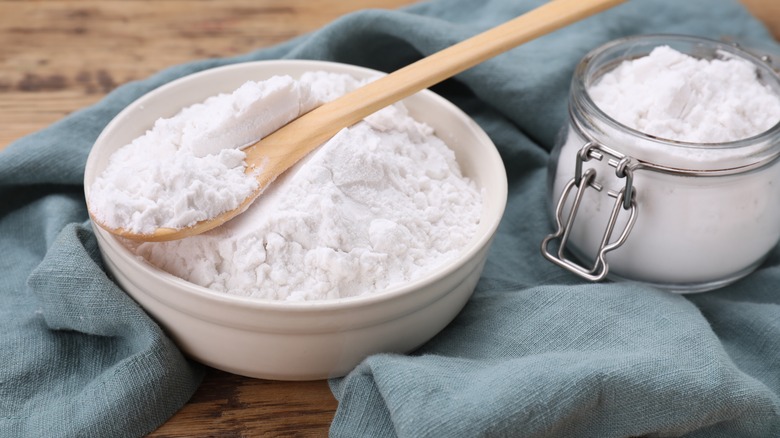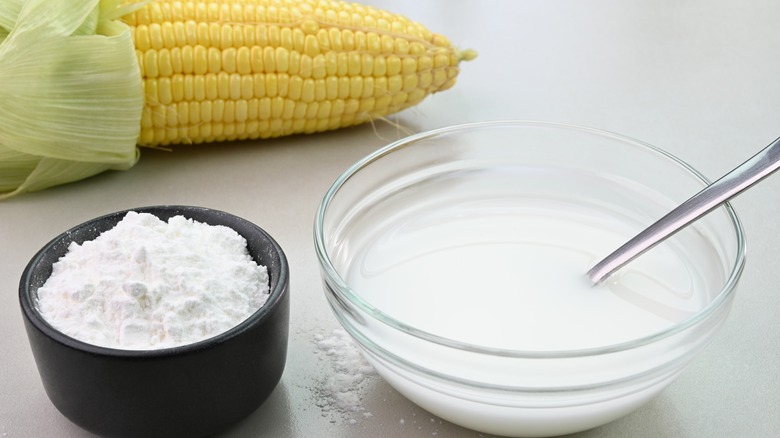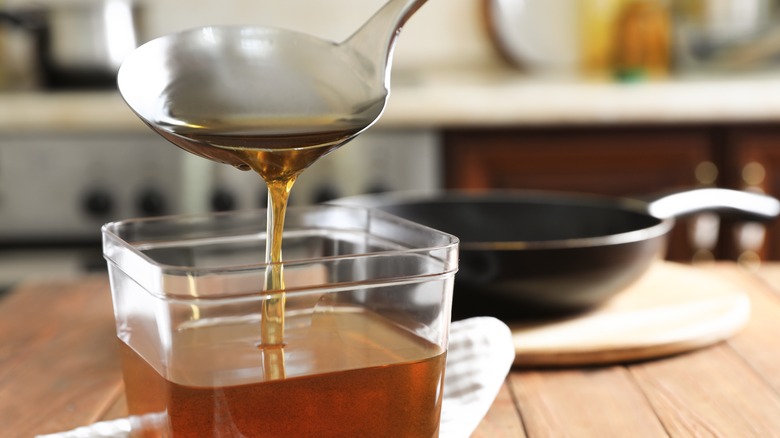Clean Your Dirty Cooking Oil With One Convenient Pantry Staple
Fried foods can be a messy and smelly chore, yet they're completely worth the effort when cravings for fried chicken, crispy onion rings, or french fries hit. Whether you're using a deep fryer or a stockpot, there's always the issue of leftover cooking oil that needs to be addressed. The good news is that, depending on what you've cooked, oil can be clarified and reused for another meal.
To reuse the cooking oil, solids must be strained out to prevent the oil from going rancid or harboring food-borne illnesses like botulism, which can potentially become fatal, as noted by Livestrong. Although you could stand over a coffee filter-lined strainer for 30 minutes, watching the oil drip slowly like an hourglass, one pantry staple can simplify the task in a fraction of the time.
Cornstarch, commonly used as a gluten-free thickening agent for soups, stews, pies, and sauces, holds the secret to clarifying dirty cooking oil in about 10 minutes. In a process similar to making oobleck, a slurry of cornstarch and water attracts the solids in the cooking oil, creating a mass that's easily strained or spooned out.
How to clean oil with cornstarch
To clean cooking oil with cornstarch conventiently, whisk together one tablespoon of cornstarch with ¼ cup of water for every cup of oil you have used. Pour the slurry into the cooled cooking oil and gently heat the mixture over low heat for about 10 minutes, being careful not to let the oil simmer. Continuously scrape the bottom of the pot with a rubber spatula to free any solids. As the oil warms, the solids will begin to clump together like magnets. You will know it's done when you see a rather unappealing mass of solids formed in the pot.
While the oil is clarifying, place a fine-mesh strainer over a container with a lid, making sure it is large enough to store the oil in the refrigerator. Pour the oil through the strainer, leaving the solid cornstarch mass behind. Alternatively, you could use a slotted spoon to remove the solids before pouring the oil into a clean container. Allow the oil to cool completely, then seal the container and store it.
The oil might look cloudy at first, but it will clear up once reheated. Even though you've removed the solids, because food particles were cooked in it, the oil should be stored in the refrigerator or freezer to maintain its quality. Before reusing the oil, let it return to room temperature.
When shouldn't you reuse cooking oil?
There's no absolute rule, but generally, cooking oil can be reused between two and eight times, depending on the type of oil and what you're frying in it, with a few exceptions. If the oil turns dark or appears dirty even after cleaning, then it's time to discard it. If the oil reaches its smoking point — which varies among oil types — or if it starts foaming, replace it with fresh oil. Also, discard the oil if it has an unpleasant odor that differs from what you previously fried in it.
Since cooking oil absorbs the flavors of the food, you probably wouldn't want to use the oil you used for frying fish for any other type of food. Conversely, it's usually acceptable to fry fish in oil that was used for frying chicken or donuts. It's a good practice to label the container with the type of food cooked in the oil, the date, and the number of times the oil has been used.
If you need to dispose of the oil, please refrain from pouring it down the drain. While it may be a liquid when warm, it can solidify and wreak havoc on your plumbing. If you have a substantial amount of oil to discard, either solidify the oil in the fridge or freezer, allowing you to dispose of it directly in the trash. Alternatively, the oil can be cooled before being placed in a sealable container, and then thrown away.



